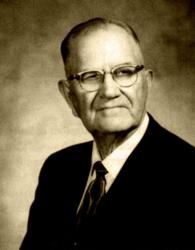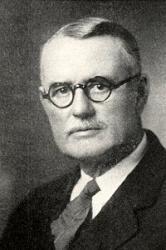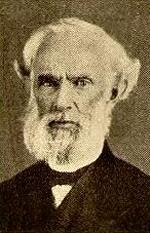Planning worship?
Check out our sister site, ZeteoSearch.org,
for 20+ additional resources related to your search.
- |
User Links
Person Results
L. O. Sanderson

1901 - 1992 Person Name: Lloyd O. Sanderson, 1901-1992 Meter: 7.6.7.6 with refrain Composer of "[The little flow'r that opens]" in Sacred Songs of the Church See also Vana R. Raye (pseudonym).
==================
Lloyd Otis Sanderson was born May 18, 1901 near Jonesboro, Arkansas. His father was a singing teacher. There were a variety of musical instruments in the home, so all of his children learned to sing and play instruments from early in life. He studied and taught music most of early teens and twenties and then began to serve churches for Churches of Christ.
Among Churches of Christ, L.O Sanderson is one of a handful of significant individuals who helped to codify the hymnody of this denomination in the early and mid 20th century. Dozens of his songs remain at the core of this group’s hymnody. As Musical Editor for the Gospel Advocate Company of Nashville during the hymnal heyday of the mid 20th century, Sanderson was responsible not only for the editing of a number of important hymnals, but for helping to shape the church’s song. He composed a number under the pen name of Vana Raye in tribute to his wife. As a composer of both lyrics and music, Sanderson collaborated with a number of individuals, the most notable being his friend, Thomas O. Chisholm, with whom he wrote “Be With Me, Lord,” perhaps his most popular hymn.
Dianne Shapiro, from Sanderson's autobiography (http://www.therestorationmovement.com/_states/tennessee/sanderson.htm) and D. J. Bulls
L. O. Sanderson
John R. Clements

1868 - 1946 Person Name: John R. Clements, 1868-1946 Meter: 7.6.7.6 with refrain Author of "No Night There" in Trinity Hymnal (Rev. ed.) John R. Clements was born in County Armagh, Ireland 28 November 1868 and was brought to the United States at the age of two years. He worked at the age of thirteen as a retail grocery clerk and had a successful wholesale grocery business. He began writing poetry when he was young.
Dianne Shapiro, from "The Singers and Their Songs: sketches of living gospel hymn writers" by Charles Hutchinson Gabriel (Chicago: The Rodeheaver Company, 1916)
John R. Clements
M. B. C. Slade

1826 - 1882 Person Name: May B. C. Slade, 1826-1882 Meter: 7.6.7.6 with refrain Author of "Who at My Door is Standing" in The Christian Hymnary. Bks. 1-4 Mary Bridges Canady Slade USA 1826-1882. Born in Fall River, MA, she was well-educated and became a minister's wife, teacher, and poet. She was assistant editor of The New England Journal of Education. She also authored hymns, Sunday school materials and books on education, primarily used for training teachers. She authored a children's magazine, “Wide-awake”. She and her husband were active in the underground railroad (helping slaves achieve their freedom). She spent her whole life living in the same town.
John Perry
M. B. C. Slade
Love H. Jameson

1811 - 1892 Person Name: Love H. Jameson, 1811-1892 Meter: 7.6.7.6 with refrain Author of "There Is a Habitation" in Sacred Songs of the Church Born: April 17, 1811, Jefferson County, Indiana.
Died: April 12, 1892, Indianapolis, Indiana.
Buried: Crown Hill Cemetery, Indianapolis, Indiana.
Love Humphreys Jameson was born in Jefferson County in what was then the Territory of Indiana on May 17, 1811, the son of Thomas Jameson. Thomas had moved from Virginia to Kentucky around 1800 and later to the Indiana Territory in 1810 or early 1811. Thomas’s parents were members of the Calvinistic Kirk of Scotland and his wife’s parents held the views of the Church of England, but the family became Christians in 1816 with Love’s father and mother being baptized by John McClung, a young associate of Barton Warren Stone. Love, whose education was attended with all the difficulties associated with frontier life and was mostly under the tuition of his parents, was baptized in the fall of 1829 during a protracted meeting with Beverly Vawter and then preached his first sermon that same year on Dec. 25, following which he began preaching the gospel regularly.
From 1830 to 1834, Jameson taught school during the winters and made preaching trips in the summers. One of his mentors was Walter Scott, with whom he frequently travelled and worked. Moving to southern Ohio, in 1834, he, along with Scott, attended the famous debate of 1837 between Alexander Campbell and Bishop Purcell at Cincinnati, OH. In addition, he wrote frequently for Campbell’s paper, The Millennial Harbinger, in which Campbell spoke of him as the brother “whose praise is in all the churches in Indiana.” After preaching at various churches in Hamilton County, OH, Jameson worked with the church in Dayton from 1835 to 1837, when he married Elizabeth M. Clark. Also, in the closing years of B. W. Stone’s life, Jameson often accompanied the elderly preacher on his journeys. In 1840 he returned to Indiana and located at Madison, IN, the following year. His wife died of an apoplectic stroke suddenly soon afterwards, and he married Elizabeth R. Robinson in 1842, moving to Indianapolis, IN, which became his headquarters for the rest of his life.
In 1845, Jameson was asked, along with John O’Kane, to evangelize in the southwestern part of the state. Then after 1854, he made regular preaching trips into Ohio, Kentucky, Western Missouri, Illinois, New York, and even portions of New England. “There is a Habitation” was penned about 1860, with both words and original music by Jameson, but it never achieved any degree of popularity because of its slow, ponderous, torpid melody. The song as we know it was first published under the title, “O Sion, Sion,” in the New Christian Hymn and Tune Book, Part II, compiled at Cincinnati, OH, in 1882 by James Henry Fillmore. Jameson, who also provided the lyrics for “Night, With Ebon Pinion,” died ten years later, on May 1, 1892, in Indianapolis.
--hymnstudiesblog.wordpress.com
Love H. Jameson
Emily R. Brink

b. 1940 Meter: 7.6.7.6 with refrain Arranger of "GO TELL IT" in Songs for Life Emily R. Brink is a Senior Research Fellow of the Calvin Institute of Christian Worship and Adjunct Professor of Church Music and Worship at Calvin Theological Seminary, Grand Rapids, Michigan. Her main areas of responsibility are conference planning and global resources. She is program manager of the annual Calvin Symposium on Worship, which draws more than 70 presenters and 1600 participants from around the world. She also travels widely to lecture and to learn about worship in different parts of the world, especially in Asia, where she has lectured in Bangladesh, China, Hong Kong, India, Indonesia, Japan, Nepal, Pakistan, Philippines, Singapore, and Taiwan.
Her areas of interest include congregational song from all times and places; psalmody; hymnal editing. She was editor of four hymnals and consults with a wide range of churches on worship renewal issues. Dr. Brink is active in the American Guild of Organists, serving in both local and national offices, as well as in the Hymn Society in the United States and Canada (president from 1990 1992) and named a Fellow of the Hymn Society in 2004 in recognition of distinguished services to hymnody and hymnology.
--internal.calvinseminary.edu/
Emily R. Brink
J. Jefferson Cleveland
1937 - 1986 Person Name: J. Jefferson Cleveland, 1937-1988 Meter: 7.6.7.6 with refrain Harmonizer of "NEAR THE CROSS" in African American Heritage Hymnal Judge Jefferson Cleveland (1937-1986) was one of the most important scholars and editors of African-American congregational song of the 20th century. Along with Verogla Nix, he edited what is arguably the most groundbreaking collection of African-American song in the last half of the 20th century, Songs of Zion (1981/1982).
Lutheran hymnologist Marilyn Stulken provides a biographical sketch of Cleveland’s life and accomplishments. Born in Georgia, Cleveland graduated from Clark College (Atlanta), Illinois Wesleyan University and received his doctorate in education from Boston University.
He served on the faculty of three historically black Christian colleges: Claflin College (South Carolina), Langston University (Oklahoma), and Jarvis Christian College (Texas), before teaching at the University of Massachusetts and Wesley Theological Seminary in Washington, D.C.
Cleveland’s musical arrangements, historical research and scholarship on the performance practice of African-American song have proven invaluable for the advancement of black gospel song, not only among African Americans, but also in Anglo hymnals to the present day. For example, Cleveland’s essay, “A Historical Account of the Hymn in the Black Worship Experience,” in Songs of Zion is a helpful introduction for laypersons and scholars alike.
In addition to serving as a hymnody consultant for the United Methodist General Board of Discipleship, he toured the United States and Africa in 1981 and Europe in 1984 as a teacher, lecturer and performer.
--www.umportal.org/
J. Jefferson Cleveland
M. Janie Leatherman
Meter: 7.6.7.6 with refrain Composer of "[Some days are dark and dreary]" in Church Hymnal, Mennonite
M. Janie Leatherman
Melchior Teschner
1584 - 1635 Meter: 7.6.7.6 with refrain Composer of "ST. THEODULPH" in The Book of Common Praise Melchior Teschner (b. Fraustadt [now Wschowa, Poland], Silesia, 1584; d. Oberpritschen, near Fraustadt, 1635) studied philosophy, theology, and music at the University of Frankfurt an-der-Oder and later studied at the universities of Helmstedt and Wittenberg, Germany. From 1609 until 1614 he served as cantor in the Lutheran church in Fraustadt, and from 1614 until his death he was pastor of the church in Oberpritschen.
Bert Polman
Melchior Teschner
David Evans
1874 - 1948 Person Name: David Evans (1874-1948) Meter: 7.6.7.6 with refrain Harmonizer of "ST. THEODULPH" in Church Hymnary (4th ed.) David Evans (b. Resolven, Glamorganshire, Wales, 1874; d. Rosllannerchrugog, Denbighshire, Wales, 1948) was an important leader in Welsh church music. Educated at Arnold College, Swansea, and at University College, Cardiff, he received a doctorate in music from Oxford University. His longest professional post was as professor of music at University College in Cardiff (1903-1939), where he organized a large music department. He was also a well-known and respected judge at Welsh hymn-singing festivals and a composer of many orchestral and choral works, anthems, service music, and hymn tunes.
Bert Polman
David Evans
Jane M. Campbell

1817 - 1878 Meter: 7.6.7.6 with refrain Translator of "We Plough the Fields, and Scatter" in Seth Parker's Hymnal Campbell, Jane Montgomery, daughter of the Rev. A. Montgomery Campbell, born in London, 1817, died at Bovey Tracey, Nov. 15, 1878. Miss Campbell contributed in 1861, a number of translations from the German to the Rev. C. S. Bere's Garland of Songs; or, an English Liederkranz, 1862; and also to his Children’s Choral Book, 1869. The best known and most widely used of these translations is a portion of "Im Anfang war's auf Erden," as the harvest hymn, "We plough the fields and scatter.” Miss Campbell also published A Handbook for Singers, Lond., Society for Promoting Christian Knowledge, n.d. This small work contains the musical exercises which she taught in her father's parish school.
--John Julian, Dictionary of Hymnology (1907)
Jane M. Campbell


 My Starred Hymns
My Starred Hymns


